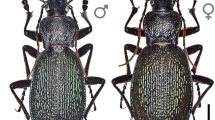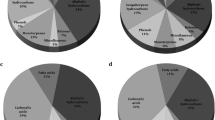Abstract
The metapleural gland is exclusive to ants, and unusual among exocrine glands in having no mechanism for closure and retention of secretion. As yet, no clear conclusion has been reached as to the function of metapleural gland secretion. Metapleural gland secretions were investigated for fungus-growing ants representing the derived attines Trachymyrmex fuscus, Atta laevigata, and Acromyrmex coronatus, the basal attines Apterostigma pilosum and Mycetarotes parallelus, and non-fungus-growing ants of the tribes Ectatommini (Ectatomma brunneum) and Myrmicini (Pogonomyrmex naegeli). Our results showed that the secretions of leaf-cutting ants (A. laevigata and A. coronatus) and the derived attine, T. fuscus, contain a greater variety and larger quantities of volatile compounds than those of myrmicine and ectatommine ants. The most abundant compounds found in the metapleural glands of A. laevigata and A. coronatus were hydroxyacids, and phenylacetic acid (only in A. laevigata). Indole was present in all groups examined, while skatole was found in large quantities only in attines. Ketones and aldehydes are present in the secretion of some attines. Esters are present in the metapleural gland secretion of all species examined, although mainly in A. laevigata, A. coronatus, and T. fuscus. Compared with basal attines and non-fungus-growing ants, the metapleural glands of leaf-cutting ants produce more acidic compounds that may have an antibiotic or antifungal function.

Similar content being viewed by others
References
Attygalle, A. B. and Morgan, E. D. 1984. Chemicals from the glands of ants. Chem. Soc. Rev. 13:245–278.
Attygalle, A. B., Siegel, B., Vostowsky, O., Bestmann, H. J., and Maschwitz, U. 1989. Chemical composition and function of metapleural gland secretion of the ant, Crematogaster deformis Smith (Hymenoptera: Myrmicinae). J. Chem. Ecol. 15:317–328.
Beattie, A. J., Turnbull, C., Knox, R. B., and Williams, E. G. 1984. Ant inhibition of pollen function: a possible reason why ant pollination is rare. Am. J. Bot. 71:421–426.
Beattie, A. J., Turnbull, C., Hough, T., Jobson, S., and Knox, R. B. 1985. The vulnerability of pollen and fungal spores to ant secretions: evidence and some evolutionary implications. Am. J. Bot. 72:606–614.
Beattie, A. J., Turnbull, C., Hough, T., and Knox, R. B. 1986. Antibiotic production: A possible function for the metapleural glands of ants (Hymenoptera: Formicidae). Ann. Entomol. Soc. Am. 79:448–450.
Bolton, B. 2003. Synopsis and classification of formicidae. Mem. Am. Entomol. Inst. 71:1–370.
Bot, A. N. M., Obermayer, M. L., Hölldobler, B., and Boomsma, J. J. 2001. Functional morphology of the metapleural gland in the leaf-cutting ant Acromyrmex octospinosus. Ins. Soc. 48:63–66.
Bot, A. N. M., Ortius-Lechner, D., Finster, K., Maile, R., and Boomsma, J. J. 2002. Variable sensitivity of fungi and bacteria to compounds produced by the metapleural glands of leaf-cutting ants. Ins. Soc. 49:363–370.
Cabrera, A., Williams, D., Hernández, J. V., Caetano, F. H., and Jaffé, K. 2004. Metapleural-and postpharyngeal-gland secretions from workers of the ants Solenopsis invicta and S. geminate. Chem. Biodiv. 1:303–311.
Cammaerts, M.-C. and Cammaerts, R. 2001. Marking of nest entrances and vicinity in two related Tetramorium ant species (Hymenoptera: Formicidae). J. Ins. Behav. 14:247–269.
Cowles, P. B. 1941. The germicidal action of the hydrogen ion and of the lower fatty acids. Yale J. Biol. Med. 13:571–578.
de Souza, A. L. B., Soares, I. M. F., Cyrino, L. T., and Serrão, J. E. 2006. The metapleural gland in two subspecies of Acromyrmex subterraneus (Hymenoptera: Formicidae). Sociobiology 47:19–25.
do Nascimento, R. R. D., Schoeters, E., Morgan, E. D., Billen, J., and Stradling, D. J. 1996. Chemistry of metapleural gland secretions of three attine ants, Atta sexdens rubropilosa, Atta cephalotes, and Acromyrmex octospinosus (Hymenoptera: Formicidae). J. Chem. Ecol. 22:987–1000.
Fales, H. M., Jones, T. H., Jaouni, T., Blum, M. S., and Schmidt, J. O. 1992. Phenylalkenals in ponerine (Leptogenys sp.) and myrmicine (Pogonomyrmex sp.). J. Chem. Ecol. 18:847–854.
Fernández-Marín, H., Zimmerman, J., Rehner, S., and Wcislo, W. 2006. Active use of the metapleural glands by ants in controlling fungal infection. Proc. R. Soc. Lond. B. Biol. Sci. 273:1689–1695.
Graystock, P. and Hughes, W. O. H. 2011. Disease resistance in a weaver ant, Polyrhachis dives, and the role of antibiotic-producing glands. Behav. Ecol. Sociobiol. 65:2319–2327.
Gusmão, L. G. 2000. pp. 60, Estudo comparado da glândula metapleural e sua secreção em diferentes castas de três espécies de Atta (Hymenoptera: Formicidae). Tese (Doutorado)—ESALQ-USP, Piracicaba.
Hamilton, W. D. 1987. Kinship, recognition, disease, and intelligence: Constraints of social evolution, pp. 81–100, in Y. Ito, J. L. Brown, and J. Kirkkawa (eds.), Animal Societies: Theories and Facts. Japan Scientific Societies Press, Tokyo.
Hölldobler, B. and Engel-Siegel, H. 1985. On the metapleural gland in ants. Psyche 91:201–224.
Hölldobler, B. and Wilson, E. O. 1990. pp. 732, The Ants. Harvard University Press, Cambridge.
Hughes, W. H. O. and Boomsma, J. J. 2004. Genetic diversity and disease resistance in leaf-cutting ant societies. Evolution 58:1251–1260.
Hughes, W. O. H., Pagliarini, R., Madsen, H. B., Dijkstra, M. J., and Boomsma, J. J. 2008. Antimicrobial defence shows an abrupt evolutionary transition in the fungus-growing ants. Evolution 62:1252–1257.
Iwanawi, Y. 1978. Myrmicacin, a new inhibitor for mitotic progression after metaphase. Protoplasma 95:267–271.
Jaffé, K. and Puche, H. 1984. Colony-specific territorial marking with the metapleural gland secretion in the ant Solenopsis geminata (Fabr.). J. Insect. Physiol. 30:265–270.
Jaffé, K., Lopez, M. E., and Aragort, W. 1986. On the communication systems of the ants Pseudomyrmex termitarius and P. triplarinus. Ins. Soc. 33:105–117.
Johnson, R. N., Agapow, P.-M., and Crozier, R. H. 2003. A tree island approach to inferring phylogeny in the ant subfamily Formicinae, with especial reference to the evolution of weaving. Mol. Phylogenet. Evol. 29:317–330.
Jones, T. H., Brunner, S. R., Edwards, A. A., Davidson, D. W., and Sneling, R. R. 2005. 6-Alkylsalicylic acids and 6-alkylresorcylic acids from ants in the genus Crematogaster from Brunei. J. Chem. Ecol. 31:407–417.
Junqueira, L. C. and Carneiro, J. 2008. pp. 524, Histologia básica, 11th ed. Guanabara Koogan, Rio de Janeiro.
Maile, R., Dani, F. R., Jones, G. R., Morgan, E. D., and Ortius, D. 1998. Sampling techniques for gas chromatographic–mass spectrometric analysis of long-chain free fatty acids from insect exocrine glands. J. Chromatogr. A 816:169–175.
Maschwitz, U. 1974. Vergleichende Untersuchungen zur Funktion der Ameisenmetathorakaldrüse. Oecologia 16:303–310.
Maschwitz, U., Koob, K., and Schildknecht, H. 1970. Ein Beitrag zur Funktion der Metathorakaldrüse der Ameisen. J. Insect. Physiol. 16:387–404.
Morgan, E. D. 1990. Preparation of small-scale samples from insects for chromatography. Anal. Chim. Acta 236:227–235.
Morgan, E. D. 2008. Chemical sorcery for sociality: Exocrine secretions of ants (Hymenoptera: Formicidae). Myrmecol. News 11:79–90.
Mueller, U. G. 2002. Ant versus fungus versus mutualism: Ant-cultivar conflict and the deconstruction of the attine ant-fungus symbiosis. Amer. Nat. 160:S67–S98.
Mueller, U. G., Schultz, T. R., Currie, C. R., Adams, R. M., and Malloch, D. 2001. The origin of the attine ant-fungus mutualism. Q. Rev. Biol. 76(2):169–197.
North, R. D., Jackson, C. W., and Howse, P. E. 1997. Evolutionary aspects of anti-fungus interactions in leaf-cutting ants. Tree 12:386–389.
Ortius-Lechner, D., Maile, R., Morgan, E. D., and Boomsma, J. J. 2000. Metapleural gland secretion of the leaf-cutter ant Acromyrmex octospinosus: New compounds and their functional significance. J. Chem. Ecol. 26:1667–1683.
Poulsen, M., Bot, A. N. M., Nielsen, M. G., and Boomsma, J. J. 2002. Experimental evidence for the costs and hygienic significance of the antibiotic metapleural gland secretion in leaf-cutting ants. Behav. Ecol. Sociobiol. 52:151–157.
Poulsen, M., Bot, A. N. M., and Boomsma, J. J. 2003. The effect of metapleural gland secretion on the growth of a mutualistic bacterium on the cuticle of leaf-cutting ants. Naturwissenschaften 90:406–409.
Schildknecht, H. and Koob, U. 1970. Plant bioregutators in the metathoracic glands of myrmicine ants. Angew. Chem. Int. Ed. Engl. 9:173.
Schildknecht, H. and Koob, K. 1971. Myrmicacin, the first insect herbicide. Angew. Chem. 10:124–125.
Schildknecht, H., Reed, P. B., Reed, F. D., and Koob, K. 1973. Auxin activity in the symbiosis of leaf-cutting ants their fungus. Insect. Biochem. 3:439–442.
Schmid-Hempel, P. 2000. Mating, parasites and other trials of life in social insects. Microb. Infect. 2:515–520.
Schoeters, E., and Billen, J. 1992. Morphological and ultrastructural study of metapleural gland in Diacamma (Hymenoptera, Formicidae), in European Congress of Social Insects, 1o, Leuven (1991) Proceedings Leuven, Leuven University. pp 239–247.
Schultz, T. R. and Brady, S. G. 2008. Major evolutionary transitions in ant agriculture. Proc. Natl. Acad. Sci. 105:5435–5440.
Seidel, J. L., Epstein, W. W., and Davidson, D. W. 1990. Neotropical ant gardens: I. Chemical constituents. J. Chem. Ecol. 16:1791–1816.
Solomon, S. E., Mueller, U. G., Schultz, T. R., Currie, C. R., and Price, S. L. 2004. Nesting biology of the fungus growing ants Mycetarotes emery (Attini, Formicidae). Ins. Soc. 51:333–338.
Spoehr, H. A., Smith, J. H. C., Strain, H. H., Milner, H. W., and Hardin, G. J. 1949. pp. 36–68, Fatty Acid Antibacterials From Plants. Carnegie Institution of Washington Publications, Washington, DC.
Sumner, S., Hughes, W. H. O., Pedersen, J. S., and Boomsma, J. J. 2004. Ant parasite queens revert to mating singly. Nature 428:35–36.
Tulloch, G. S., Shapiro, J. E., and Hershenov, B. 1962. The ultrastructure of the metasternal glands of ants. Bull. Brooklyn. Entomol. Soc. 57:91–101.
vander Meer, R. 2012. Ant interactions with soil organisms and associated semiochemicals. J. Chem. Ecol. 38:728–745.
Vieira, A. S., Bueno, O. C., and Camargo-Mathias, M. I. 2010. The functional morphology of the metapleural gland of the leaf-cutting ant Atta laevigata (Formicidae: Attini). Micron 41:149–157.
Vieira, A. S., Bueno, O. C., and Camargo-Mathias, M. I. 2011. Secretory profile of metapleural gland cells of the leaf-cutting ant Acromyrmex coronatus (Formicidae: Attini). Microsc. Res. Tech. 74:76–83.
Vieira, A. S., Bueno, O. C., and Camargo-Mathias, M. I. 2012a. Ultrastructural profile of metapleural gland cells of the ant Atta laevigata (F. Smith, 1858) (Formicidae: Attini). Anim. Biol. 62:1–11.
Vieira, A. S., Bueno, O. C., and Camargo-Mathias, M. I. 2012b. Morphophysiological differences between the metapleural glands of fungus-growing and non-fungus growing ants (Hymenoptera, Formicidae). PLoS One 7:e43570.
Villesen, P., Mueller, U. G., Schultz, T. R., Adams, R. M., and Bouck, A. C. 2004. Evolution of ant-cultivar specialization and cultivar switching in Apterostigma fungus-growing ants. Evolution 58:2252–2265.
Voegtle, H. L., Jones, T. H., Davidson, D. W., and Snelling, R. R. 2008. E-2-ethylhexenal, E-2-ethyl-2-hexenol, mellein, and 4-hydroxymellein in Camponotus species from Brunei. J. Chem. Ecol. 34:215–219.
Weber, N. A. 1972. pp. 146, Gardening Ants: The Attines, Vol. 92. American Philosophical Society, Philadelphia (PA).
Yek, S. H. and Mueller, U. G. 2011. The metapleural gland of ants. Biol. Rev. 86:774–791.
Acknowledgements
The authors thank the Center for Study of Social Insects (Centro de Estudos de Insetos Sociais – CEIS – UNESP/SP/Brazil – São Paulo State University) for assistance in the collection and identification of specimens used in this study. IAV thanks Keele University for study support, and FAPESP (São Paulo Research Foundation) for financial support (grant 2008/54301-3) and CNPq (researcher grant).
Author information
Authors and Affiliations
Corresponding author
Rights and permissions
About this article
Cite this article
Vieira, A.S., Morgan, E.D., Drijfhout, F.P. et al. Chemical Composition of Metapleural Gland Secretions of Fungus-Growing and Non-fungus-growing Ants. J Chem Ecol 38, 1289–1297 (2012). https://doi.org/10.1007/s10886-012-0185-8
Received:
Revised:
Accepted:
Published:
Issue Date:
DOI: https://doi.org/10.1007/s10886-012-0185-8




